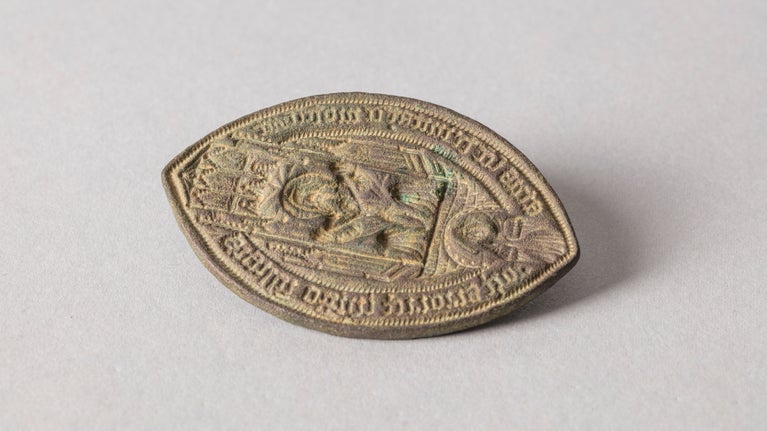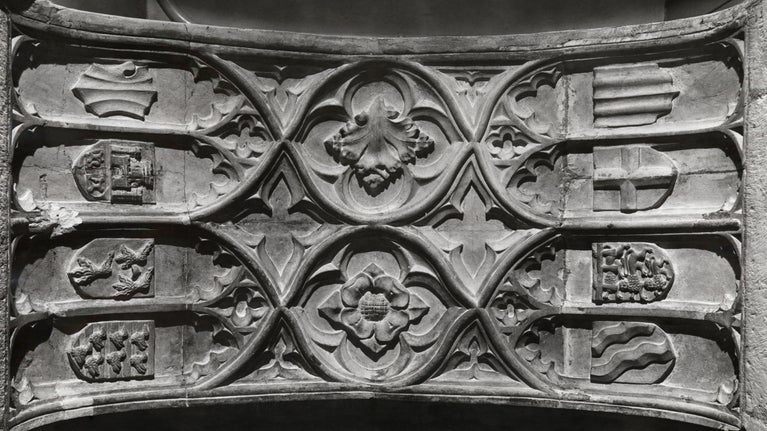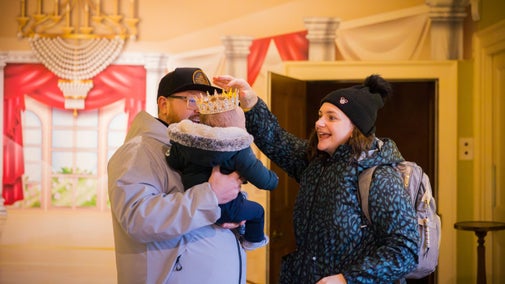
Discover more at Mottisfont
Find out when Mottisfont is open, how to get here, the things to see and do and more.

Mottisfont Abbey, Hampshire began life as an Augustinian priory before being converted into a home for William, 1st Baron Sandys in 1536. It stayed with his descendants for nearly four centuries. In 1934, Maud and Gilbert Russell purchased Mottisfont, and later commissioned the artist Rex Whistler to paint a Gothic-inspired scheme in the Drawing Room. Today, Mottisfont is celebrated for its internationally significant rose garden and its important collection of 20th-century art.
The name Mottisfont is often linked to the natural spring, called a font, which produces water on the site. It is not known when the spring was discovered, but a parish church and small village were established by the time of Domesday Book in 1086.
In 1201, one of England’s most important royal officials, William Brewer (d. 1226), founded a priory on the land around the font. It was a good location. The font provided running water, and the site was well placed to attract religious pilgrims travelling between the great Christian shrines of Salisbury and Winchester.
The Priory housed a small religious community of ordained priests, known as canons, who lived and worshipped together. The priory buildings were centred on the church which had cloisters to the south along with places for the canons to eat and sleep. The sick were cared for in the infirmary and the home farm provided food. There were also gardens and orchards surrounding the Priory, and water from the font powered a watermill.
The Priory was never particularly rich when compared to other religious foundations in England. The Black Death, a bubonic plague which spread across Europe in the 1340s, devasted the Priory, killing many of the canons and draining its finances. The surviving members appealed to the Pope to grant permission for them to sell indulgences – documents which promised the bearer a faster ascent into heaven after death.
By the 1530s, these efforts, along with support from a new benefactor, the Southampton merchant Henry Huttoft (fl. 1506–40), put the Priory into a better financial position.

Like all religious houses in England and Wales, Mottisfont Priory was affected by the Reformation which occurred after King Henry VIII separated from the Roman Catholic Church. In 1536, Mottisfont Priory was supressed and closed. It was stripped of many of its valuable possessions, and the canons were sent elsewhere. Soon the buildings and wider estate were sold to William, 1st Baron Sandys. He purchased Mottisfont by swapping it for land he held in Chelsea and Paddington.
Sandys was an important member of Henry VIII’s court. He served in many positions, including Lord Chamberlain. He already owned The Vyne, a house in Hampshire, where he had entertained Henry and his then wife, Anne Boleyn, in 1535.
Sandys was an experienced builder, having carried out extensive work at The Vyne and on the English fortress at Guisnes (now Guînes) in Northern France. He took a pragmatic approach to converting Mottisfont’s old Priory buildings into his new house. He retained, rather than demolished, many of the old buildings. This included the Priory church into which he inserted new walls and floors. He also kept the cloisters and surrounding buildings and built a second courtyard to provide further accommodation.
William died before the work to convert the Priory into a house was completed. His family used it as a second Hampshire home until the 1650s. When The Vyne was sold in 1653, Mottisfont became their main home.
At first glance, little of Sandys’s Tudor house appears to survive. However, the layout of the main house, hidden behind later fabric and decoration, dates to his time. This includes the arrangement of many of the principal rooms and the Long Gallery. In the 1500s, the house was of sufficient status and size to receive royal progresses. On these occasions the monarch and their court required suitable accommodation and meals. A total of three progresses are known: King Edward VI visited in September 1552 and Queen Elizabeth I visited in 1569 and 1574.

In 1684, Edwin Sandys, 8th and last Baron Sandys (1638–84) died without any children. The house and its estate passed to his nephew, Sir John Mill. The Mill family made their money as merchants in Southampton and, on inheriting the Mottisfont estate, they lived here as comfortable country squires.
By 1740, the earlier Tudor house started to look dated and old-fashioned. The older courtyards were demolished and classical features such as the pediment were added to the south front.
In 1835, the estate passed to a cousin, Reverend John Barker (1803–60). He was the last owner of the house to be a descendant of William, 1st Baron Sandys. On taking his inheritance, he was granted a baronetcy and took the Mill name, becoming Sir John Barker-Mill. He enjoyed spending his new-found wealth and renovating the house. He discovered several hidden medieval features, including the pulpitum arch (a surviving feature of the Priory church which once separated the nave and choir) in the kitchen. He also built a new stable block to indulge his passion for horse racing and hunting.
On Sir John’s death, the house passed to his cousin Marianne Vaudrey (1846–1932). Although she took his surname to become a Barker-Mill, she never lived in the house. Instead, she rented it out. Her eldest son Claude (1874–1916) lived briefly in the house, but after his death in the First World War, it was unoccupied. On Marianne’s death, her grandson Peter (1908–94) inherited the house and sold the contents at auction in 1933. One year later he sold the house to Maud and Gilbert Russell.
Maud (1891–1982) was the daughter of the Jewish Anglo-German banker Paul Nelke, and Maria Conrad, who moved to London in the 1880s. Maud was born there in 1892. Her husband Gilbert (1875–1942) was a cousin of the Duke of Bedford, and a descendant of the former Prime Minister Lord John Russell. They met in 1916 and were married soon afterwards. They lived in London and their sons Martin and Raymond were born in 1918 and 1922. Maud’s father helped set Gilbert up in banking. Their wealth allowed Maud to form an important modern art collection, which included a portrait of herself by Henri Matisse.
After renting large country houses for many summers, Maud and Gilbert eventually settled on purchasing Mottisfont Abbey. It allowed Gilbert to indulge his sporting passions and gave Maud a blank canvas to renovate and decorate. Maud revitalised the house, modernising the facilities and painting brighter schemes in many of the rooms in recognition of its Georgian past.
In the former entrance hall, she commissioned the artist Rex Whistler to paint a ‘Gothic’ mural celebrating the house’s medieval origins. The result was a room full of trompe l’oeil decoration, creating the impression of a large decorative plasterwork ceiling and arches filled with trophies representing the Russell family. On the west wall is an urn billowing with smoke towards the ceiling. Whistler even painted the marble fireplace and curtain pelmets.
At the house, the Russells hosted regular weekends of their friends including Duff and Diana Cooper, Cecil Beaton and Ian Fleming – a mixture of politicians, artists and journalists.
After Gilbert’s death in 1942, Maud was in a relationship with the Russian-born artist Boris Anrep (1883–1969). Famed for his work in mosaics, including the ‘Modern Virtues’ floor at London’s National Gallery, Maud became the major patron and promoter of his work. Two of his mosaics are now at Mottisfont Abbey, including his tribute to Maud, ‘The Angel of Mottisfont’.
In 1957, Maud donated the house and estate to the National Trust, continuing to live at Mottisfont until 1972.

Shortly after Maud Russell moved out of the Abbey, the National Trust’s garden advisor Graham Stuart Thomas (1909–2003) selected part of the house’s walled garden as suitable for planting his collection of pre-1900 shrub roses. Flowering once a year, this is now an internationally famous collection of plants.
The house’s collection has benefitted in recent years from generous donations. This includes Derek Hill’s (1916–2000) gift of part of his art collection, including works by Degas, Bonnard and Lowry. The Russell family have also donated pieces of furniture previously removed from the property, as well as works of art including the McAvoy portrait of Maud Russell. Other acquisitions have included an equestrian portrait of Sir John Barker-Mill and a seal matrix associated with the Priory.
Inspired by Maud Russell’s art collecting and patronage, there have also been artist-in-residence schemes and a regular exhibition programme.
Nikki Frater, Rex Whistler; The Artist and his Patrons (London, 2024).
Tessa Lecomber, The Barker-Mill Story; A Hampshire Family since the 16th Century (Ashurst, 2000).
Emily Russell (ed.), A Constant Heart; The War Diaries of Maud Russell 1938-1945 (Wimborne Minster, 2017).
Neil S. Rushton and Christopher K. Currie, ‘Land Management and Custumal Diversity on the Estate of Mottisfont Priory in the 1340s’, Proceedings of the Hampshire Field Club and Archaeological Society, 56 (2001), pp.202-218 (Available at Hampshire Field Club Volume 51.pdf (hantsfieldclub.org.uk)).

Find out when Mottisfont is open, how to get here, the things to see and do and more.
Explore Maud Russell’s 1930s neo-classical interiors, in an 18th-century house with medieval origins and enjoy changing art exhibitions in the spacious gallery.

Mottisfont offers a fantastic family day out, with something for everyone. As well as the wild play area, scenic river and meadow, there are specially-designed activities for pre-schoolers and exciting events every school holiday. Enjoy perfect winter picnic spots, delicious treats from our cafés, and convenient baby-changing facilities - all in a beautiful, welcoming environment.

Learn about people from the past, discover remarkable works of art and brush up on your knowledge of architecture and gardens.

Explore the objects and works of art we care for at Mottisfont on the National Trust Collections website.
